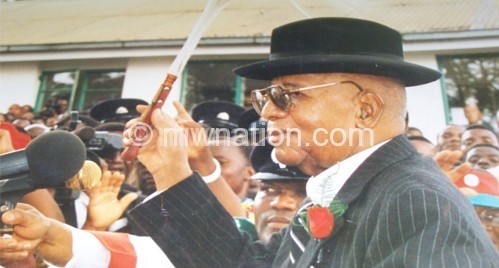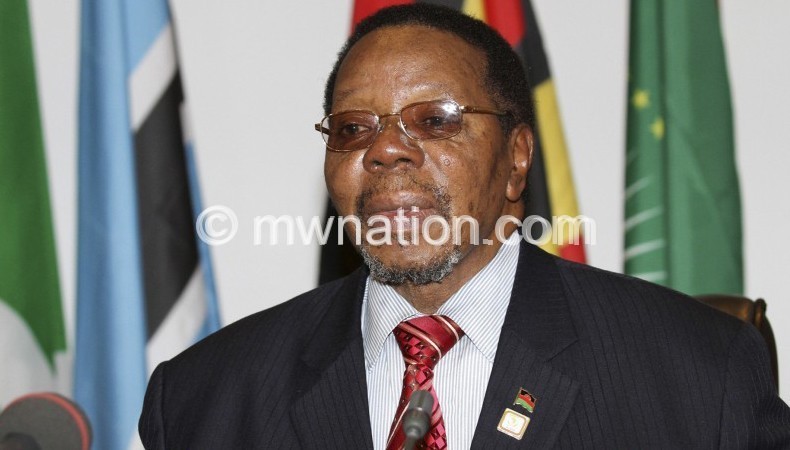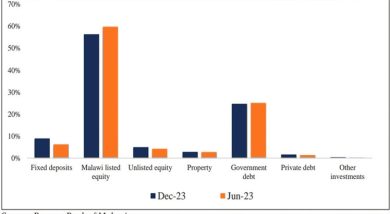Reflecting on Malawi’s 50 years of post-independence gains and losses
Introduction
This week Malawi celebrated 50 years of independence. During these 50 years there have been episodes of progress punctuated by tragedies of missed opportunities and inconsistent policy development and implementation. It is now an opportune time to reflect on the last 50 years and learn from the past, to understand the present and shape the new future.

Since independence Malawi has pursued an agricultural-led development strategy based on the promotion of a dual agricultural system comprising estate (large-scale) production mainly for cash (export) crops and smallholder agricultural production for the purposes of food security. Despite the different names and adjectives that have been used to describe the development path, the country has been obsessed with four objectives since 1964, albeit, with priorities over the different time periods since independence. The four objectives are in no particular order to raise agricultural productivity and accelerate growth and export performance; to diversify the export base from the dominance of tobacco and tea exports; indigenise estate (large-scale) agriculture and to encourage production by smallholder farmers.
Yet, after all these efforts and the substantial investment in monetary terms, Malawi is still ranked one of the poorest countries in the world.
Agricultural led development strategy with bias towards Estate Agriculture (1964-1979)
Immediately after independence, the country witnessed quite rapid economic growth with an annual average rate of increase in GDP was over five percent between 1964 and 1979 and the country’s GDP per capita more than doubled. The agricultural led development strategy was bearing fruits in that the growth of the economy was based on agriculture. This period was characterised by the absence of a significant private sector in manufacturing and almost zero mineral extraction. Kamuzu Banda’s strategy led to an agricultural growth pattern built on bias between the estate and the smallholder sectors. It was based on a notion of exploiting the smallholder farmers to drive estate-led growth. It was therefore no surprise that the estate sector grew at annual average of over 10 percent, and yet the smallholder sector only registered an average of three percent during the period.

The benefits of Kamuzu’s development strategy were evident in that during this period there were remarkable improvements in the well being of the people. The rate of infant mortality reduced to 130 per 1 000 from 200 per 1 000 in 1964. The smallholder food production increased and as a result the per capita daily calorie intake increased from 2,250 in 1964 to 2,400 in 1975. The bias against smallholder farmers manifested in itself through growing income inequalities which reached levels of 0.448 by 1979. At the end of the 1970s the top 10 percent of the population received 50 percent of national income.
While Kamuzu’s development strategy was clear and consistent, it was unsustainable in the long run. The strategy based on getting land from smallholders, using rural people as sources of labour for estates and siphoning profits from smallholder farmers through Admarc’s trading surplus on smallholder tobacco, cotton and groundnuts and channelling the profits into investments in estates was a short term solution.
Indeed by 1979, there were signs of the unsustainability of this model of development. The per capita grain production in the country reduced to 210 kg per individual from 240 kg per individual at independence in 1964. This coupled by an increasing population that had doubled to about 6 million from 3.9 million in 1965.
The Crisis of Development and IMF’s Structural Adjustment Policies (1980-1999)

The effects of the 1964-1979 development trajectory resulted in a number of issues that needed to be addressed. It was evident by per capita incomes as the country’s economy grew (GDP) by an average of 2.5 percent between 1979 and 1996, coupled with a higher population growth rate, the per capita income was one of the lowest in the world.
Malawi was a typical case of a poor country that needed donor support and therefore needed painful but necessary dosage of structural adjustment. The Banda vision of Malawi was falling apart and the country religiously swallowed the IMF and World Bank stabilisation and structural adjustment programmes. Despite the total compliance with the conditions of the structural adjustment programmes the situation was critical and unstable and in intensive care
Agricultural production was severely affected as a result of the shrinking of average land holding sizes and by 1996 the calorie intake per individual had gone down to 2 100 from the 1975 level of 2 400 per individual. When the multi-party government of Bakili Muluzi came into power the country was under severe problems. With the 1990s came the most severe HIV/Aids outbreaks, a reduction the rate of improvement in infant mortality and the average life expectancy had gone down. Malawi’s income inequality was the third worst in the world by 1995 when it reached an index of 0.62 beaten only by Brazil and Namibia.
By 1995, Malawi’s domestic savings fell to zero and investment was at the level that was not even adequate to replaced existing capital stock. Things were indeed falling apart. It seemed winning a second term in the 1999 elections was the only game in town for the government, there was no strategic direction in government actions and behaviour.
The lost decade of Malawi’s development (1998-2004)

Many commentators have dubbed President Muluzi’s second term as one of the worst development performances in the history of Malawi. It was a period that Malawians need to draw lessons from. The average economic growth rate between and 2003 was a dismal 1.6 percent, way below the country’s population growth rate.
The forces of nature also conspired with the economic meltdown. An acute food crisis of food availability affected a significant proportion of the populations. Those that have lived long enough claim that it was the worst famine in living memory, certainly worse than the drought of 1991/92, and worse even than the Nyasaland famine of 1949 because it resulted in several hundred hunger-related deaths (perhaps several thousand).
Panic set in as manifested in the complete break-down of the state’s capacity to formulate and implement policy. It was the period of massive misappropriation of public resources, collapse of state service provision, extensive fiscal indiscipline and consequent macro-economic instability culminating in inflation averaging 27 percent per annum and nominal interest rates of over 44 percent.
Hope restored but only for a while (2004-2010)

When Dr Bingu Mutharika took office in 2004, the economy was on a brink of collapse. It is perhaps only fair to describe the first term of Bingu’s presidency as the best since 1964 in terms of economic indicators. The annual economic growth rate was 75 between 2004 and 2009, actually almost nine percent in 2009. For the first time in the multi party dispensation, Malawi’s economic growth was well above the average for the five percent The country’s wealth as measured by GDP increased over 40 percent from $1.8 billion to $2.5 billion in constant ($ 2000 prices). Malawi’s per capita rose by 30 percent reaching $166 from a value of $130 in 1994. These achievements are remarkable when one considers the fact that there were happening during the period of global economic recession.
These achievements can be pinned down to several factors; macroeconomic stability, improved policy coherence, strengthened national ownership of development policy and an effective input subsidy programme to support smallholder farmers.
The result was that between 2004 and 2010, national policy focused on macroeconomic stability, low interest rates and the control of inflation and both contributed to and benefited from increased agricultural production. The statistics bear witness to the progress. Malawi’s inflation rate, which reached levels above 70 percent in the 1990s and early 2000s fell to seven percent per year at the end of July 2010. The increased food production was key to curbing inflation since large part of the Consumer Price Index basket is food (58 percent), and as maize is a large component of this.
The leadership element was critical in Bingu’s first term and the substantial progress made despite lacking a parliamentary majority was rewarded by the Malawi population through a resounding endorsement in the 2009 elections. President Mutharika’s DPP was re elected for a second term in office (2009–2014) with a 60 percent majority in the 193-seat Parliament
The two years to forget (2010-2012)
In 2010 and 2011 Parliament passed a number of laws perceived as weakening democratic institutions and human rights. Politics and economics got into conflict. Bad politics makes bad economics. What started as a political judgement error soon became and economic crisis. In June 2011 an IMF Extended Credit Facility (ECF), approved in February 2010, was suspended and other donors suspended budget support due to politics and yet the victim was economics.
Suspension of donor aid worsened Malawi’s fiscal and external imbalances and further tilted an already severely imbalanced economy. Reserves, nevertheless, dwindled dramatically and domestic borrowing soared. With the exchange rate fixed, a severe foreign exchange deficit contributed forex shortages that prevented adequate purchases of fuel and other imports, leading to domestic fuel and imported goods shortages and other negative collateral effects on the broader economy. Getting fuel was an art that required a sophisticated network of long queues and intelligence as to when and where one would get fuel. Power shortages became the norm by April 2012.
The last mile of the 50 years (2012-2014)
On April 7, 2012 the last mile of the 50 years of independence began with the swearing in of Mrs Joyce Mtila Banda as the fourth president and first female president of Malawi. Banda quickly moved to restore donor confidence by repealing several laws and instituting several economic reforms. A few days into office, Banda devalued and floated the kwacha.
In the short run, Banda’s currency devaluation proved economically and politically challenging. It resulted in an immediate 31 percent rise in fuel prices and an increase in annual inflation to 25 percent by August and maize prices increased by 47 percent.
The new Banda government crafted the Economic Recovery Plan (ERP) which laid out short- and medium-term implementation plan for achieving poverty eradication. The plan identified projects in five key areas that could lead to lead growth and achieve quick results. These areas include: commercial agriculture (including value addition), tourism, energy, mining and infrastructure development. This plan was supplemented by the National Export Promotion Strategy (NES), which provides a prioritised road map for developing Malawi’s productive base and improving the country’s export competitiveness.
On the economic front the economy grew from 1.9 percent in 2012 to about five percent in 2013, mainly on account of an improved harvest (due to improved weather) and increased availability of foreign exchange.
The new government instituted austerity measures to restore economic stability. However, political naivety took over economic prudence. An increase of 80 percent in cabinet ministers’ travel stipends soon jolted Malawians into reality. This was at odds with the austerity message that Banda has generally tried to foster. Frequent domestic travels by the president and her cabinet did not help to stabilise the economy.
In early October 2013, reports of misappropriation of significant amounts of public funds through amounting to over K9 billion or 0.7 percent of GDP surfaced. This was the turning point for the darling of the IMF. The third review of the IMF scheduled for October was postponed.
The scandal sparked public outrage and the perceived inability and lack of seriousness in dealing with it was the final nail on the coffin as donors suspended disbursements of financial assistance to the budget. The immediate impact of the aid freeze was a delay in disbursements of general budget support and dedicated grants (mainly targeted at social sectors) amounting to about $180 million in the second fiscal quarter (October – December 2013), equivalent to about 55 percent of the total budget support and dedicated grants for the year.






Inu a Nation muziauza anthu Kuti
Fanwell kenala Bokosi is Ph. D holder from the university of Kent .
well written analysis
We must celebrate the fact that after 50 years of independence; we are one of the only countries in Africa and arguably the world as a whole to have not had any significant conflict or war. We must also celebrate the fact that the natural beauty known as Malawi has remained virtually untouched for these years and is hardly facing some of the problems that many parts of the world are facing such as global warming. But, to maintain this, we must; have harsh regulations on deforestation and poaching and we must also CANCEL THE PLANS TO DRILL OIL OUT OF LAKE MALAWI!